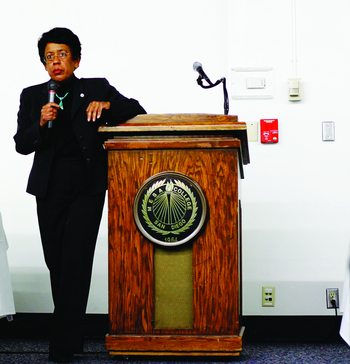The San Diego Community College District is keeping its head above water financially despite a state budget hold, owing the district $34 million for funding and Cal Grants.
This year’s Chancellor’s Forum was held on Sept. 28 at Mesa College where Chancellor Constance Carroll talked about the district’s current financial situation and gave an estimate of the fee increases that Mesa Students can expect for the following year. Carroll has been the district chancellor for seven years, with an additional 11 years as the president of Mesa College. Carroll said holding the forum at Mesa College was like “coming home.”
The California Constitution mandates that a state budget be in place by July 1 of each year. As of early October the state has barely agreed on a budget, but things are still shaky in Sacramento. The absence of a fully stable budget has resulted in a statewide freeze on Cal Grants, forcing colleges to dip into their reserves for their month-to-month expenses. As the state postpones the budget decision the college districts are waiting on their money and students from other college districts are waiting on their grants.
“No one is getting money from the state, that includes students,” said Carroll.
There are some in the California Legislature who would like to see the budget deferred as late as December, however an agreement over the current revised budget makes it unlikely that funding will be postponed that long.
Even with the state’s current hold placed on Cal Grant payments, the SDCCD has continued to pay students their Cal Grants. Vice Chancellor Terry Davis went into detail about the SDCCD’s monetary reserves and how financial planning from as early as 2006 has helped keep them from borrowing money.
“We are not borrowing,” said Davis. “We are paying the Cal Grants, because we have that reserve.”
When Carroll and her staff witnessed the federal and state’s financial downturn they began a financial strategy that is keeping the district fiscally healthy for the time being. With a hiring freeze they were able to prevent layoffs and by implementing bond measures early they filled their reserves enough to thrive through the postponed state payments.
The third consecutive delay in funding wasn’t the only topic of discussion. There are once again talks of increasing the unit cost for SDCCD students. Carroll said she expects the price of classes will be increased to about $30 a unit, but no decisions have been made at the state level. Currently only 2% of the unit cost stays with the college district, while the other 98% is first filtered through the state before it finds its way back to the college. Carroll would like to see the fee increase stay within the district so that the money could be immediately applied to the college while waiting for a state budget to pass.
Community colleges are funded by the state via the Full Time Equivalent Students (FTES) enrollment count. Only a student that is attending full time classes counts as a FTES, while the units of part time students are added together until they equal full time status to count as one FTES. Because the funding is calculated by FTES and not per student, the SDCCD is actually accommodating more students than the state is funding.
Once the budget is passed the SDCCD reserve funds will be replenished, but for now the only thing the SDCCD can do is wait and work out a strategy for further delays as Sacramento gets things organized.
“Who holds Sacramento’s feet to the fire?” asked Madeleine Hinkes, the head Mesa College’s anthropology program.
Carroll said voters can correct the system and encouraged everyone to vote during the November elections. It is the responsibility of the public to stay informed.
New buildings like the Student Services Center, Design Center, Central Plant and the Math/Science Building are all fully funded and scheduled for construction at Mesa College.
SDCCD is staying ahead of the financial crisis and they are also one of the few college districts in California that is still expanding.

